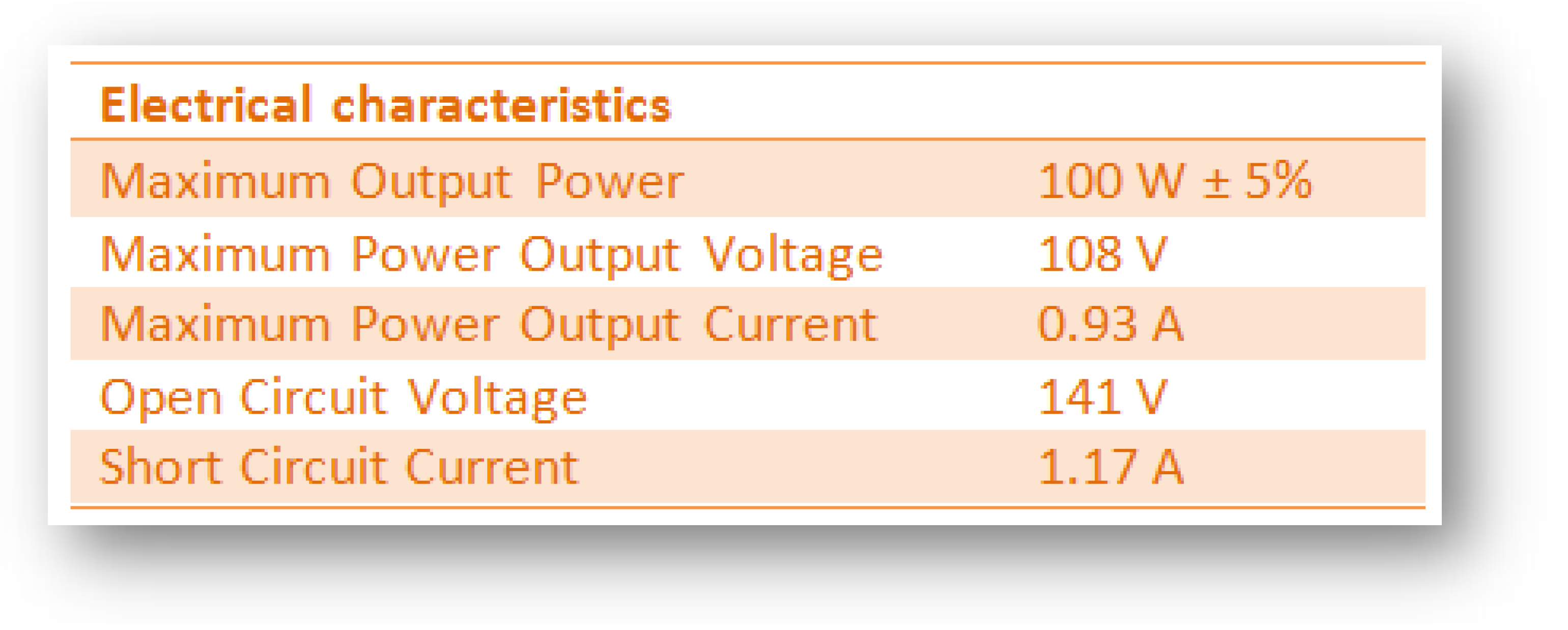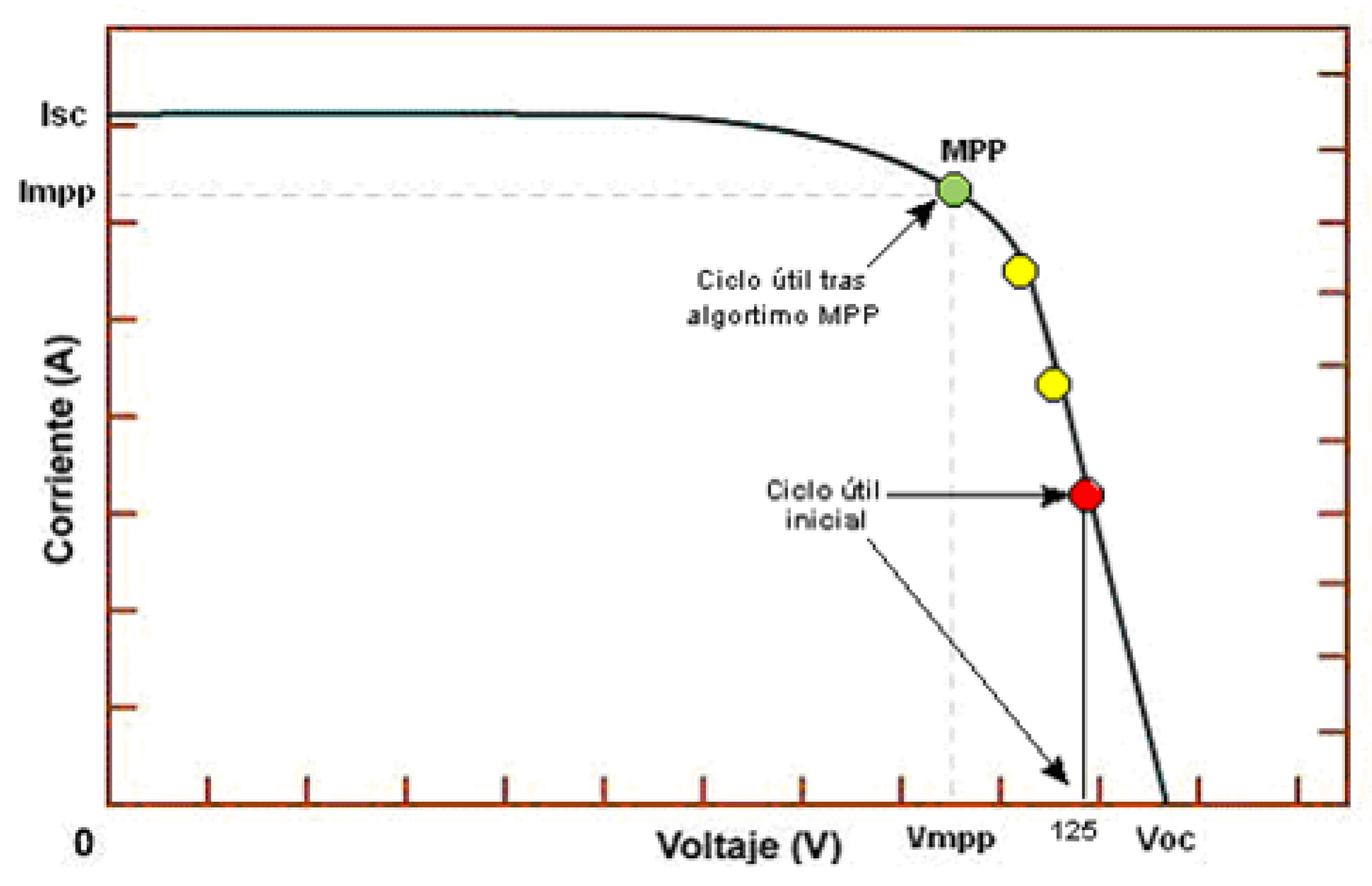Universal Solar Battery Charger for Off-Grid Storage Systems †
1. Summary
2. Project Introduction
2.1. MPP Trackers State of the Art
- Perturbe and Observe (P&O): Simple and low cost. Typical accuracies of 80%.
- Incremental conductance: Complex and high cost (high computation devices required). Accuracies over 90%.
- Voltage control/Current control: Very simple and low cost. Accuracies over 70% are reached.
- Voltage/current sweep: Complex, medium cost. Accuracies over 90%.
- Load current/voltage maximization: Simple and low cost. Efficiencies over 90%. Just possible if the load is at constant voltage or constant current.
2.2. DC/DC Converter
3. Project Development
3.1. Power Stage Design
3.2. Control Stage MPPT
4. Final Results and Conclusions
Author Contributions
Conflicts of Interest
References
- EPIA. Global Market Outlook for Photovoltaics until 2016; EPIA: Taipei, Taiwan, 2012. [Google Scholar]
- Solar Power Europe. Global Market Outlook for Solar Power/2016–2020; Solar Power Europe: Brussels, Belgium, 2017. [Google Scholar]
- Photovoltaic Systems Engineering. Roger A. Messenger y Jerry Ventre; CRC Press: Hoboken, NJ, USA, 2010. [Google Scholar]
- Mitsubishi Heavy Industries, Ltd. Mitsubishi MA Series; Mitsubishi Heavy Industries, Ltd.: Tokyo, Japan, 2018. [Google Scholar]
- Image. Available online: http://solar.nmsu.edu/wp_guide/energia.html (accessed on 1 December 2008).
- Zainudin, H.N.; Mekhilef, S. Comparison Study of Maximum Power Point Tracker Techniques for PV Systems. In Proceedings of the 14th International Middle East Power Systems Conference, Cairo, Egypt, 19–21 December 2010. [Google Scholar]
- Fernández, J.A.; García, F.N. Topologías para la Conversión Energética Utilizando Como Fuente Primaria un Panel Fotovoltaico. Pre-. Doctoral Thesis, University of Oviedo, Asturias, Spain, 2006. [Google Scholar]
- Arias, J.; Linera, F.F.; Martin-Ramos, J.; Pernia, A.M.; Cambronero, J. A Modular PV Regulator Based on Microcontroller with Maximum Power Point Tracking. In Proceedings of the 39th IAS Annual Meeting, Blacksburg, VA, USA, 3–7 October 2004. [Google Scholar]
- Du, Y.; Lu, D.D.-C. Battery-integrated boost converter utilizing distributed MPPT configuration for photovoltaic Systems. Sol. Energy 2011, 85, 1992–2002. [Google Scholar] [CrossRef]



| Battery | Output Power with Solution | Efficiency | Output Power with Direct Connection |
|---|---|---|---|
| 12V | 72.38W | 72.28% | 13.92W |
| 24V | 92.78W | 91.76% | 27.48W |
| 48V | 95.04W | 94.6% | 53.52W |
| 72V | 96.5W | 96% | 77.76W |
| Irradiance | Pav Panel | P Extract | P Batt | ηcc/cc | ηDC/DC+MPPT |
|---|---|---|---|---|---|
| 1000W/m2 | 100W | 99W | 72W | 72.7% | 72% |
| 800W/m2 | 72.75W | 71W | 54W | 76% | 74.2% |
| 600W/m2 | 57W | 56W | 45W | 80.3% | 78.9% |
Publisher’s Note: MDPI stays neutral with regard to jurisdictional claims in published maps and institutional affiliations. |
© 2018 by the authors. Licensee MDPI, Basel, Switzerland. This article is an open access article distributed under the terms and conditions of the Creative Commons Attribution (CC BY) license (https://creativecommons.org/licenses/by/4.0/).
Share and Cite
Gustavo, Á.D.; Pablo, P.S.J.; Fernando, N.G.; Jorge, X.B. Universal Solar Battery Charger for Off-Grid Storage Systems. Proceedings 2018, 2, 1482. https://doi.org/10.3390/proceedings2231482
Gustavo ÁD, Pablo PSJ, Fernando NG, Jorge XB. Universal Solar Battery Charger for Off-Grid Storage Systems. Proceedings. 2018; 2(23):1482. https://doi.org/10.3390/proceedings2231482
Chicago/Turabian StyleGustavo, Álvarez Díaz, Paredes Sánchez J. Pablo, Nuño García Fernando, and Xiberta Bernat Jorge. 2018. "Universal Solar Battery Charger for Off-Grid Storage Systems" Proceedings 2, no. 23: 1482. https://doi.org/10.3390/proceedings2231482
APA StyleGustavo, Á. D., Pablo, P. S. J., Fernando, N. G., & Jorge, X. B. (2018). Universal Solar Battery Charger for Off-Grid Storage Systems. Proceedings, 2(23), 1482. https://doi.org/10.3390/proceedings2231482






